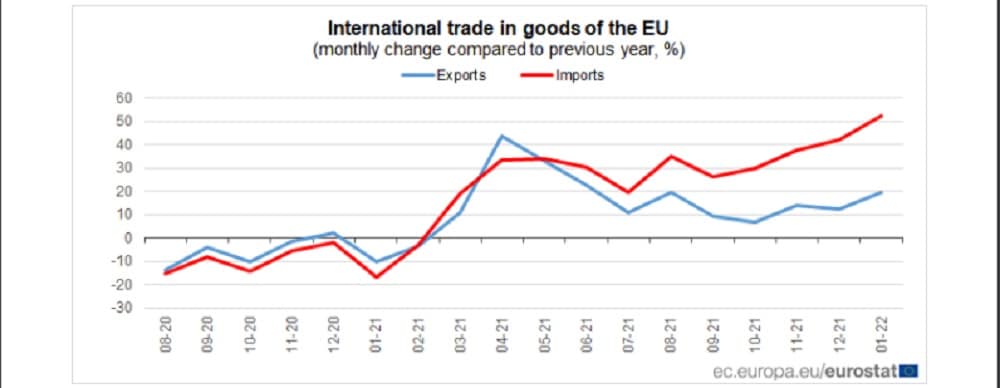(CN) — The increasing costs of importing energy drove the European Union’s international trade deficit to 36 billion euros ($39.7 billion) in January, up 18.9% from the previous year, according to data released by Eurostat on Friday.
The EU spent 52.4% more on imports in January 2022 compared with 2021, adding up to 214.3 billion euros ($236.5 billion) out of pocket. At the same time, the EU exported 178.2 billion euros ($196.6 billion) worth of goods outside of the region and traded 299.6 billion euros ($330 billion) within member states.
By contrast, the 27-nation bloc entered 2021 with a trade surplus of 67.9 billion euros ($74.9 billion).
Even as EU energy exports increased 84% throughout 2021, energy imports increased 133%, and remain the greatest contribution to the trade deficit by industry.

In the midst of Russia's invasion of Ukraine, energy imports have also fueled inflation spikes across Europe. The EU imports more than a quarter of its crude oil from Russia, along with 46% of solid fuel and 40% of natural gas.
Energy imports vary across member states, with Cyprus importing 100% of its energy. France and Croatia import more than three-quarters of their energy. Several countries import less than a quarter of their energy, including Lithuania, Spain, Luxembourg, Poland and Italy, according to Eurostat.
In 2021, the EU exported 0.6% fewer goods to China than the previous year, reflecting the organization’s only decline among its top trading partners. At the same time, Chinese imports to the EU increased by 48% — creating the greatest deficit between the EU and a top trading partner. EU exports to the U.S. and the United Kingdom increased 25% while imports swelled from the two countries as well.
At 70%, Cyprus reported the highest increase in exports outside of the EU, following by Romania and Greece at about 44%. While all member states saw increases in exports, Slovakia and Denmark reported the lowest increases at or below 10%.
With increases above 100%, Lithuania and Croatia topped EU import increases in 2021. Cyprus reported the increase in imports, at about 10%.
Subscribe to Closing Arguments
Sign up for new weekly newsletter Closing Arguments to get the latest about ongoing trials, major litigation and hot cases and rulings in courthouses around the U.S. and the world.









